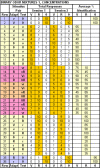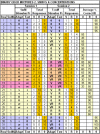Time and intensity factors in identification of components of odor mixtures
- PMID: 20720093
- PMCID: PMC2955077
- DOI: 10.1093/chemse/bjq078
Time and intensity factors in identification of components of odor mixtures
Abstract
Identification of odors of compounds introduced into changeable olfactory environments is the essence of olfactory coding, which focuses perception on the latest stimulus with the greatest salience. Effects of stimulus intensity and adapting time on mixture component identification after adapting with one component were each studied in 10 human subjects. Odors of 1 and 5 mM vanillin (vanilla) and phenethyl alcohol (rose) were identified, with adapting time varied by sniffing naturally once or twice, or sniffing 5 times, once every 2 s. Odors of water-adapted single compounds were identified nearly perfectly (94%), self-adapted to 51% but did not cross-adapt (94%), showing the 2 compounds had quickly adapting independent odors. Identifications of the vanilla and rose odors in water-adapted mixtures were reduced to 59% and 79%, respectively. Following single-component adaptation, the average 33% identification of odors of adapted (ambient) mixture components contrasted with the greater average 86% identification of new unadapted (extra) mixture components. Identifications were lower for 1 than 5 mM components when concentrations were not matched, and ambient component identifications were lower after 10-s adaptation than after 1 or 2 sniffs. Rapid selective adaptation and mixture component suppression manipulate effective intensity to promote emergence of characteristic odor qualities in dynamic natural settings.
Figures







References
-
- Axel R. Scents and sensibility: a molecular logic of olfactory perception (Nobel lecture) Angew Chem Int Ed. 2005;44:6111–6127. - PubMed
-
- Bartoshuk LM. Taste mixtures: is mixture suppression related to compression? Physiol Behav. 1975;14:643–649. - PubMed
-
- Bauer K, Garbe D, Surburg H. Common fragrance and flavor materials: preparation, properties and uses. 4th ed. Weinheim (Germany): Wiley-VCH; 2001.
-
- Bell GA, Laing DG, Panhuber H. Odour mixture suppression: evidence for a peripheral mechanism in human and rat. Brain Res. 1987;426:8–18. - PubMed
-
- Berglund B, Berglund U, Lindvall T. Olfactory self- and cross-adaptation: effects of time of adaptation on perceived odor intensity. Sens Processes. 1978;2:191–197. - PubMed
Publication types
MeSH terms
Grants and funding
LinkOut - more resources
Full Text Sources

